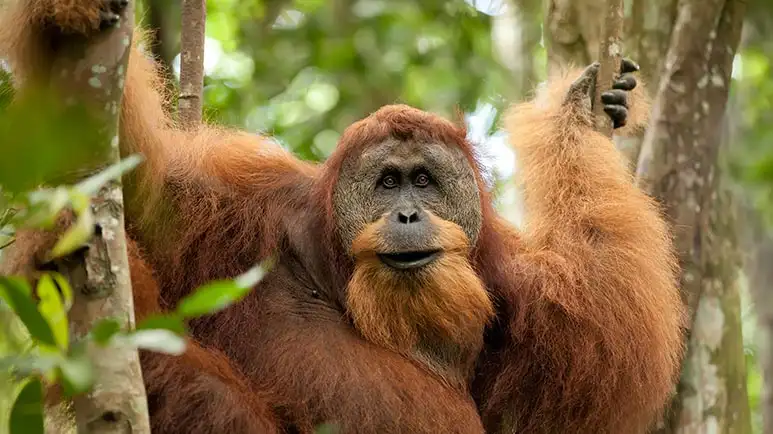Could This Hack Heal Wild Animals?
Scientists were amazed by a wild orangutan's surprising wound-treatment method. This groundbreaking observation might change our understanding of animal self-care.

STORY AT-A-GLANCE
- A recently published study reports on the first recorded observation of a wild Sumatran orangutan applying a plant with known medicinal properties to a wound
- Rakus, a male orangutan living in a protected rainforest area in Indonesia, was observed by scientists to selectively remove leaves off a tree, chew them, and repeatedly apply the resulting juice on his facial wound; the ape also rested more than usual while wounded
- After five days, the wound had closed, and no infection was present
A recently published study1 by an international team of cognitive and evolutionary biologists documents evidence of a wild male Sumatran orangutan applying a plant with known medicinal properties to a wound — a first for a wild animal.
According to a Max Planck Institute news release on the study, self-medicating through ingestion of specific plant parts is a widespread but infrequent practice among wild animals. Per the news release:
“The closest relatives to humans, the great apes, are known to ingest specific plants to treat parasite infection and to rub plant material on their skin to treat sore muscles. Recently a chimpanzee group in Gabon was observed applying insects to wounds. However, the efficiency of this behavior is still unknown. Wound treatment with a biologically active substance has so far not been documented.”2
Orangutan Rakus Treats His Facial Wound With Plant Medicine
The present study took place at the Suaq Balimbing research site in Indonesia — a protected rainforest area that is home to about 150 critically endangered Sumatran orangutans.
“During daily observations of the orangutans, we noticed that a male named Rakus had sustained a facial wound, most likely during a fight with a neighboring male,” says Isabelle Laumer of the Max Planck Institute of Animal Behavior (MPI-AB) and first author of the study.3
Three days after his injury, the orangutan “selectively ripped off leaves of a liana with the common name Akar Kuning (Fibraurea tinctoria), chewed on them, and then repeatedly applied the resulting juice precisely onto the facial wound for several minutes. As a last step, he fully covered the wound with the chewed leaves.”
“This and related liana species that can be found in tropical forests of Southeast Asia are known for their analgesic and antipyretic effects and are used in traditional medicine to treat various diseases, such as malaria,” explains Laumer. “Analyses of plant chemical compounds show the presence of furanoditerpenoids and protoberberine alkaloids, which are known to have antibacterial, anti-inflammatory, anti-fungal, antioxidant, and other biological activities of relevance to wound healing.”
The researchers observed Rakus’ wound over the following days and saw no signs of infection. After five days, the wound was already closed. The orangutan also rested more than usual while wounded. Per Laumer, sleep is beneficial for wound healing because growth hormone release, protein synthesis and cell division increase during sleep.
Was Rakus’ Self-Healing Behavior Intentional?
Scientists question whether self-medication behavior in animals is intentional, and how it emerges.
“The behavior of Rakus appeared to be intentional as he selectively treated his facial wound on his right flange, and no other body parts, with the plant juice,” says Laumer. “The behavior was also repeated several times, not only with the plant juice but also later with more solid plant material until the wound was fully covered. The entire process took a considerable amount of time.”
Caroline Schuppli, also of MPI-AB and senior author of the study, offers a possible explanation for Rakus’ behavior:
“It is possible, that wound treatment with Fibraurea tinctoria by the orangutans at Suaq emerges through individual innovation. Orangutans at the site rarely eat the plant. However, individuals may accidentally touch their wounds while feeding on this plant and thus unintentionally apply the plant's juice to their wounds. As Fibraurea tinctoria has potent analgesic effects, individuals may feel an immediate pain release, causing them to repeat the behavior several times.”4
Since Rakus’ behavior had never been seen before in the Suaq orangutan population, it’s possible his choice to self-treat with Fibraurea tinctoria was a first. None of the adult males living at the research site were born there, and Rakus’ origin is unknown.
“Orangutan males disperse from their natal area during or after puberty over long distances to either establish a new home range in another area or are moving between other's home ranges,” explains Schuppli. “Therefore, it is possible that the behavior is shown by more individuals in his natal population outside the Suaq research area.”
The study authors write:
“This possibly innovative behavior presents the first report of active wound management with a biological active substance in a great ape species and provides new insights into the existence of self-medication in our closest relatives and in the evolutionary origins of wound medication more broadly.”5
Schuppli sums it up this way:
“The treatment of human wounds was most likely first mentioned in a medical manuscript that dates back to 2200 BC, which included cleaning, plastering, and bandaging of wounds with certain wound care substances.
As forms of active wound treatment are not just human, but can also be found in both African and Asian great apes, it is possible that there exists a common underlying mechanism for the recognition and application of substances with medical or functional properties to wounds and that our last common ancestor already showed similar forms of ointment behavior.”
The study of how animals self-medicate in the wild is called zoopharmacognosy. For much more information on this topic, you can read or listen to my interview with Caroline Ingraham, founder of Applied Zoopharmacognosy here: Empowering Pets to Heal Themselves Through Self-Medication.











